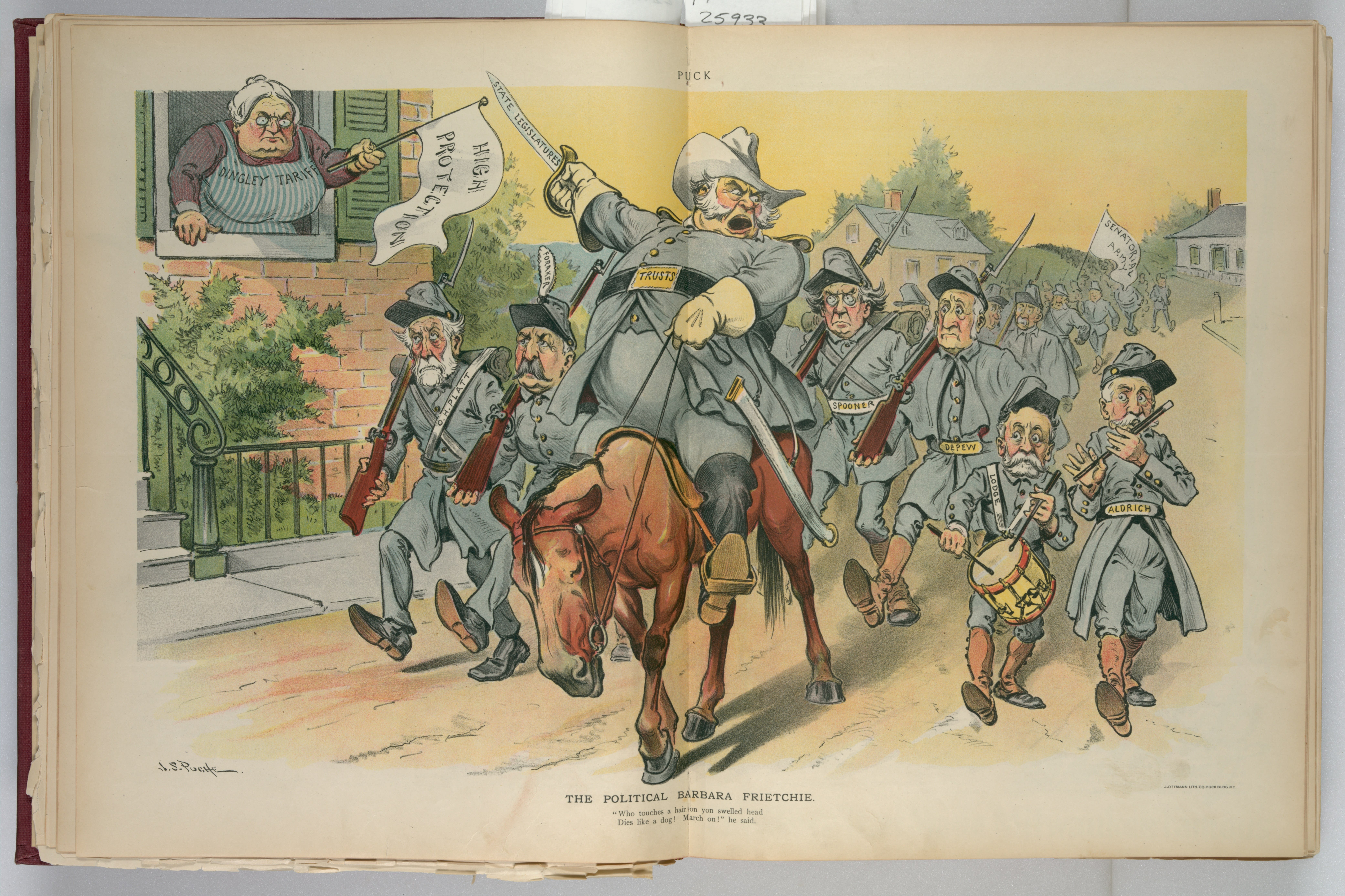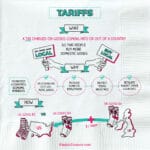The Dingley Tariff Act of 1897, the highest and longest-lasting protective tariff in U.S. history, ignited a fiery debate over its impact on American consumers and industries. Enacted as a response to the Wilson-Gorman Tariff Act of 1894, the Dingley Tariff marked a sharp reversal in U.S. trade policy, ushering in an era of high tariffs that would define the early 20th century. Let’s step back in time to uncover the fascinating story of this landmark legislation, exploring its profound and lasting effects on America.
A Nation Grappling with Economic Uncertainty
The 1890s were a time of great economic uncertainty in the United States. The Panic of 1893 had plunged the nation into a severe depression, leaving businesses struggling and unemployment soaring. Amidst this turmoil, the debate over trade policy raged.
The Wilson-Gorman Tariff Act of 1894, which had lowered tariff rates, was seen by some as a contributing factor to the economic downturn. Industries facing increased foreign competition argued for greater protection. This set the stage for the election of 1896, where the tariff emerged as a central issue.
William McKinley, a staunch advocate for protectionism, secured the presidency, signaling a shift in U.S. trade policy. The stage was set for the Dingley Tariff to take center stage.
The Dingley Tariff: A Protectionist Bulwark
Introduced by Representative Nelson Dingley Jr. and signed into law by President McKinley in 1897, the Dingley Tariff Act represented a triumphant return to protectionism. Its key provisions included:
- Increased Average Tariff Rates: The act raised the average tariff rate to a staggering 57%, making it the highest in U.S. history at the time.
- Broad Scope: Duties were imposed on a wide range of imported goods, including wool, hides, sugar, tobacco, iron, and steel. This sweeping approach aimed to safeguard numerous American industries.
- Revenue Generation: Beyond protecting domestic industries, the tariff was also designed to generate revenue for the federal government, which had faced deficits in the wake of the recent economic downturn.
The Tariff’s Ripple Effects: A Mixed Bag
The Dingley Tariff, much like a stone cast into a pond, created ripples that spread throughout American society. Its impact, however, was far from uniform, creating both winners and losers:
Economic Impacts:
- A Surge in Prices: While the tariff aimed to shield American industries, it also led to a sharp increase in the cost of living. Estimates suggest that prices rose by nearly 25% between 1897 and 1907. This burden fell disproportionately on working-class Americans who relied heavily on imported goods.
- Booming Industries, Stifled Competition: Certain industries, particularly manufacturing, flourished under the protective umbrella of the tariff. Shielded from foreign competition, these industries experienced growth and job creation. However, this protection came at the cost of potentially stifling innovation and efficiency.
- Government Revenue on the Rise: The increased taxes on imports translated into a significant revenue stream for the federal government. This allowed for investments in various public programs, but it also fueled the ongoing debate about whether tariffs were primarily a tool for economic growth or simply a means to bolster government coffers.
Political Fault Lines Deepen:
- Republicans Strengthened: The Dingley Tariff aligned perfectly with the Republican Party’s platform of protectionism. The tariff’s perceived success in stimulating certain sectors of the economy helped solidify Republican dominance during this era.
- The Tariff Debate Rages On: The Dingley Tariff intensified the long-standing debate between proponents of protectionism and advocates for freer trade. Republicans largely championed the tariff as crucial for American prosperity, while Democrats argued that it disproportionately burdened consumers and risked provoking trade wars.
Social Unrest and the Ballot Box:
- Strained Budgets, Growing Discontent: The tariff’s impact on consumers did not go unnoticed. Working-class families, already grappling with the economic anxieties of the era, felt the squeeze of higher prices most acutely. This fueled social unrest and contributed to a growing sense of economic inequality.
- A Political Backlash Brews: The 1890 midterm elections witnessed a significant shift in the political landscape, with Democrats making substantial gains. This outcome was partly attributed to public discontent with the McKinley Tariff, the Dingley Tariff’s predecessor, which had also resulted in higher prices for consumers. The message was clear: economic policies, particularly those directly affecting the cost of living, could have profound political consequences.
A Legacy of Protectionism and Debate
The Dingley Tariff’s legacy extends far beyond its immediate impacts. It solidified a trend toward protectionism in American trade policy that would persist for decades. This approach, while benefiting certain industries, would continue to spark debates about its overall impact on consumers, economic growth, and international relations.
Echoes in Modern Trade:
Even today, the Dingley Tariff serves as a potent historical example in discussions about the role of tariffs in a globalized economy. It highlights the complex trade-offs inherent in protectionist policies, reminding us that shielding domestic industries can come at the cost of higher prices for consumers and potential retaliation from trading partners.
Lessons for a Globalized World:
The Dingley Tariff, in many ways, continues to resonate in modern trade policy debates. As nations grapple with the challenges and opportunities of a globally interconnected economy, understanding the historical impact of tariffs, both their successes and their failures, remains crucial for policymakers seeking to strike a balance between protecting national interests and fostering international cooperation.
Beyond the Headlines: Uncovering Untold Stories
While the Dingley Tariff’s broad strokes are well-documented, there’s still much to uncover about its nuanced and far-reaching impacts:
- Industry-Specific Deep Dives: Exploring the tariff’s effects on specific industries, such as the sugar industry, which underwent significant transformations during this period, could offer valuable insights.
- The Tariff and American Diplomacy: Did the high tariffs imposed by the Dingley Act strain relations with other nations? Examining the tariff’s role in shaping American foreign policy during this era would provide a more comprehensive understanding of its global significance.
- Giving Voice to the People: Investigating the perspectives of different socioeconomic groups – farmers, factory workers, middle-class consumers – would shed light on how the tariff’s burden and benefits were distributed across American society.
By delving deeper into these underexplored areas, we can gain a richer understanding of how the Dingley Tariff shaped the economic, political, and social landscape of the United States.
Unveil the poignant tale of a tumultuous life lived in the shadow of societal norms in the renowned classic 1934 novel written in the form of an autobiography. Alternatively, explore the enigmatic world of ancient mysticism through the gnostic life of Mary Magdalene, uncovering the secrets shrouded within her spiritual journey.
- Discover the Borough of Frenchtown, NJ: A Delaware River Town Blending History, Art & Nature - November 22, 2024
- Discover Clarks Grove, MN: A Small Town with a Big Heart - November 22, 2024
- Califon Borough, NJ: A Small Town with a Big Heart (and Rich History) - November 22, 2024













